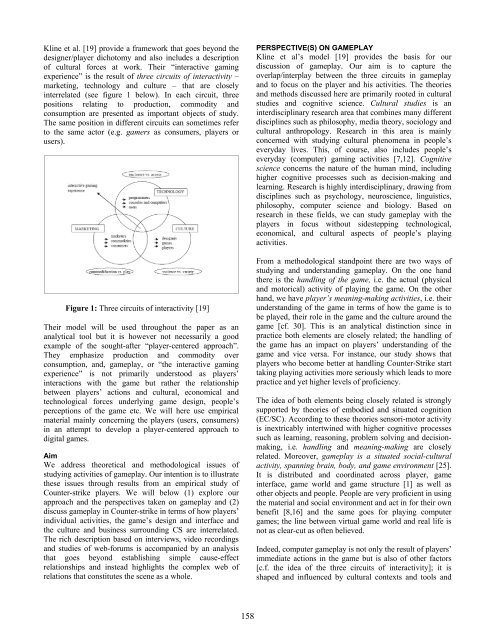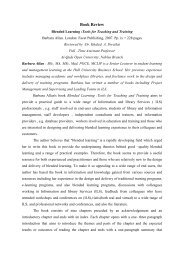07313.16293
You also want an ePaper? Increase the reach of your titles
YUMPU automatically turns print PDFs into web optimized ePapers that Google loves.
Kline et al. [19] provide a framework that goes beyond the<br />
designer/player dichotomy and also includes a description<br />
of cultural forces at work. Their “interactive gaming<br />
experience” is the result of three circuits of interactivity –<br />
marketing, technology and culture – that are closely<br />
interrelated (see figure 1 below). In each circuit, three<br />
positions relating to production, commodity and<br />
consumption are presented as important objects of study.<br />
The same position in different circuits can sometimes refer<br />
to the same actor (e.g. gamers as consumers, players or<br />
users).<br />
Figure 1: Three circuits of interactivity [19]<br />
Their model will be used throughout the paper as an<br />
analytical tool but it is however not necessarily a good<br />
example of the sought-after “player-centered approach”.<br />
They emphasize production and commodity over<br />
consumption, and, gameplay, or “the interactive gaming<br />
experience” is not primarily understood as players’<br />
interactions with the game but rather the relationship<br />
between players’ actions and cultural, economical and<br />
technological forces underlying game design, people’s<br />
perceptions of the game etc. We will here use empirical<br />
material mainly concerning the players (users, consumers)<br />
in an attempt to develop a player-centered approach to<br />
digital games.<br />
Aim<br />
We address theoretical and methodological issues of<br />
studying activities of gameplay. Our intention is to illustrate<br />
these issues through results from an empirical study of<br />
Counter-strike players. We will below (1) explore our<br />
approach and the perspectives taken on gameplay and (2)<br />
discuss gameplay in Counter-strike in terms of how players’<br />
individual activities, the game’s design and interface and<br />
the culture and business surrounding CS are interrelated.<br />
The rich description based on interviews, video recordings<br />
and studies of web-forums is accompanied by an analysis<br />
that goes beyond establishing simple cause-effect<br />
relationships and instead highlights the complex web of<br />
relations that constitutes the scene as a whole.<br />
PERSPECTIVE(S) ON GAMEPLAY<br />
Kline et al’s model [19] provides the basis for our<br />
discussion of gameplay. Our aim is to capture the<br />
overlap/interplay between the three circuits in gameplay<br />
and to focus on the player and his activities. The theories<br />
and methods discussed here are primarily rooted in cultural<br />
studies and cognitive science. Cultural studies is an<br />
interdisciplinary research area that combines many different<br />
disciplines such as philosophy, media theory, sociology and<br />
cultural anthropology. Research in this area is mainly<br />
concerned with studying cultural phenomena in people’s<br />
everyday lives. This, of course, also includes people’s<br />
everyday (computer) gaming activities [7,12]. Cognitive<br />
science concerns the nature of the human mind, including<br />
higher cognitive processes such as decision-making and<br />
learning. Research is highly interdisciplinary, drawing from<br />
disciplines such as psychology, neuroscience, linguistics,<br />
philosophy, computer science and biology. Based on<br />
research in these fields, we can study gameplay with the<br />
players in focus without sidestepping technological,<br />
economical, and cultural aspects of people’s playing<br />
activities.<br />
From a methodological standpoint there are two ways of<br />
studying and understanding gameplay. On the one hand<br />
there is the handling of the game, i.e. the actual (physical<br />
and motorical) activity of playing the game. On the other<br />
hand, we have player’s meaning-making activities, i.e. their<br />
understanding of the game in terms of how the game is to<br />
be played, their role in the game and the culture around the<br />
game [cf. 30]. This is an analytical distinction since in<br />
practice both elements are closely related; the handling of<br />
the game has an impact on players’ understanding of the<br />
game and vice versa. For instance, our study shows that<br />
players who become better at handling Counter-Strike start<br />
taking playing activities more seriously which leads to more<br />
practice and yet higher levels of proficiency.<br />
The idea of both elements being closely related is strongly<br />
supported by theories of embodied and situated cognition<br />
(EC/SC). According to these theories sensori-motor activity<br />
is inextricably intertwined with higher cognitive processes<br />
such as learning, reasoning, problem solving and decisionmaking,<br />
i.e. handling and meaning-making are closely<br />
related. Moreover, gameplay is a situated social-cultural<br />
activity, spanning brain, body, and game environment [25].<br />
It is distributed and coordinated across player, game<br />
interface, game world and game structure [1] as well as<br />
other objects and people. People are very proficient in using<br />
the material and social environment and act in for their own<br />
benefit [8,16] and the same goes for playing computer<br />
games; the line between virtual game world and real life is<br />
not as clear-cut as often believed.<br />
Indeed, computer gameplay is not only the result of players’<br />
immediate actions in the game but is also of other factors<br />
[c.f. the idea of the three circuits of interactivity]; it is<br />
shaped and influenced by cultural contexts and tools and<br />
158





